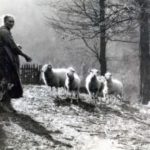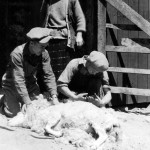Pine Mountain Settlement School
Series 11: Farm and Farming
Series 32: ART AND CRAFT Weaving
FARM Guide to Sheep, Goats, Weaving
FARM Guide to Sheep, Goats, Weaving, Natural Dyes
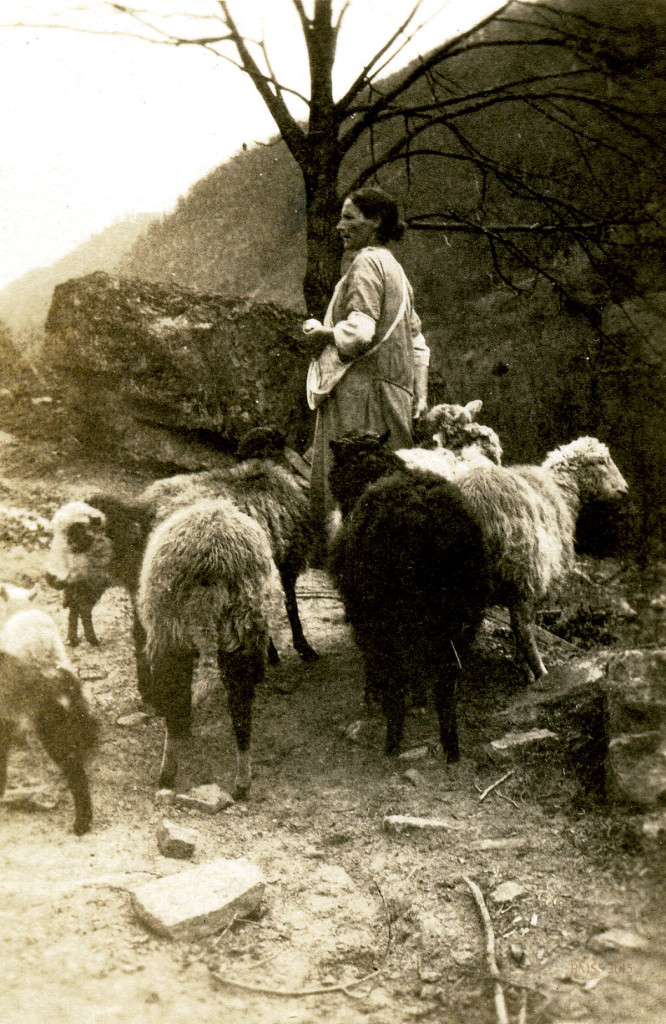
TAGS: sheep, goats, weaving, farming, sheep, dyeing, flax, wool, spinning, workshops, vegetable dye, looms, fleece, shearing, carding, wool, coverlets, patterns, blue pot, crafts people, weaving teachers, Fireside Industries, foodways, Spring Lamb, Southeastern Kentucky Sheep Producers Association (SEKSPA), Alice Cobb, Sarah Bailey, Nativity Play
POSTS
DANCING IN THE CABBAGE PATCH Community Farming (draft)
DANCING IN THE CABBAGE PATCH Farm and Dairy Early Years I
DANCING IN THE CABBAGE PATCH Farm and Dairy Early Years II
DANCING IN THE CABBAGE PATCH Farm and Dairy Morris Years III
DANCING IN THE CABBAGE PATCH Sheep (draft)
DANCING IN THE CABBAGE PATCH Weaving
DANCING IN THE CABBAGE PATCH Weaving at PMSS 1930s-1940s
DANCING IN THE CABBAGE PATCH Weaving at PMSS Beginnings
SELECTED EXCERPTS FROM PAGES ABOUT SHEEP, GOATS, WEAVING
ALICE COBB STORIES “Told by Miss Pettit” – Great story about Aunt Nance Templeton shearing, dyeing and weaving sheep wool and working with flax to make alternate dresses for her wedding day, depending on the weather.
ALICE COBB STORIES Logging in Gabes Branch and Holiness Service, 1937 – Mrs. Hensley: “We didn’t have ‘ary cent of money. Just lived off the land. I raised sheep and spun the wool for clothes, and we had a cow. We got along, but it was hard.”
CHRISTMAS Mummers Play – An excerpt:
FATHER CHRISTMAS
I am Father Christmas! Hold, men, hold.
Be there loaf in your locker, and sheep in your fold,
A fire on your hearth, and good luck for your lot,
Money in your pocket, and pudding in the pot.
CHRISTMAS Nativity Play, page 4 – An excerpt from THE SHEPHERD SCENE:
(3rd Shepherd)
“Yes, the sheep are our life;
Without them, no wife, no home, no child.
And cold though it be,
This life suits me best.
Not for me fishing on the lake,
And peddling the fish through the town.
I stay by the sheep.“
COMMUNITY Fair Day 1914-1915 Farmer’s Meetings – In a letter from Marguerite Butler to her mother, November 1914: “Yesterday the school cooked dinner for all out in...big black kettles in the open. The men killed a sheep Saturday for the great affair.”
COMMUNITY FAIR DAY 1919 – Goat and sheep-related items to be exhibited by the community:
Goats wool – [Helen Wilmer] Stone [Viner]
Natural wools – [Helen Wilmer] Stone
Wh. [White] Sheeps wool – Mrs. Farley
Natural wool – Mary Lewis
White sheep – Mary Lewis
DARWIN D. MARTIN Letter from Wm. Martin, brother, 1916, pages 4-5 – “Corn and potatoes seem to be about all that farmers raise. There is no incentive to raise fruit altho it is said to be a fine fruit country, because there is no way to get fruit to market. Sheep are a good asset but lambs have to be kept close to shelter until almost full grown on account of catamounts (wild cats).“
DEAR FRIEND LETTERS 1957 December – Burton Rogers writes about changes at PMSS, including from unprofitable dairying and poultry to sheep and forestry to find the most suitable farm activities for the area.
DEAR FRIEND LETTERS 1961 May 20, page 2 – Burton Rogers writes ““A weaving workshop, held here in February under the auspices of the Southern Highland Handicraft Guild, stimulated renewed interest in weaving, spinning and vegetable dyeing. several neighbors are now working at looms….” and may be a source of extra income to some in the community.
DEAR FRIEND LETTER 1964 December – In a fundraising letter written by Rebecca Caudill Ayars, an author who visited PMSS, is a mention of sheep when she describes the conditions that the children in the PMSS area face: “Most of them are on a dead end street. Their mountains are impoverished. Farming, except for subsistence farming…is gone. Sheep raising is gone. …”
EVELYN K. WELLS 1916 Excerpts From Letters Home – John Callahan “brought six goats with him as a present to Miss de Long and Miss Pettit.”
EVELYN K. WELLS 1917 Excerpts From Letters Home – 1917 November 13. page 9 – “The shadow of the war is over us. We are glad of such diversions as teaching the children a new song-ballet — tonight “The Raggle-Taggle Gypsies.” But we still have sugar and can buy beef at 12 cents a pound and a sheep for $4.00.”
EVELYN K. WELLS 1918 Excerpts From Letters Home – In 1918, Evelyn Wells wrote to her family, “Spinning goes on on Far House porch, and the wool piles up. It’s a good job for Aunt Leah Smith, and she’s done about forty hanks. The other day I called on Aunt Sis Shell [Mary Elizabeth Nolan Shell]. She took me into the bedroom to see her wool, the fleeces of 50 sheep, black, Southdown and white, piled high on three feather beds, we have picked out some fleeces — mine, a lovely Southdown, gray-brown, to be woven into a linsey skirt for next winter.”
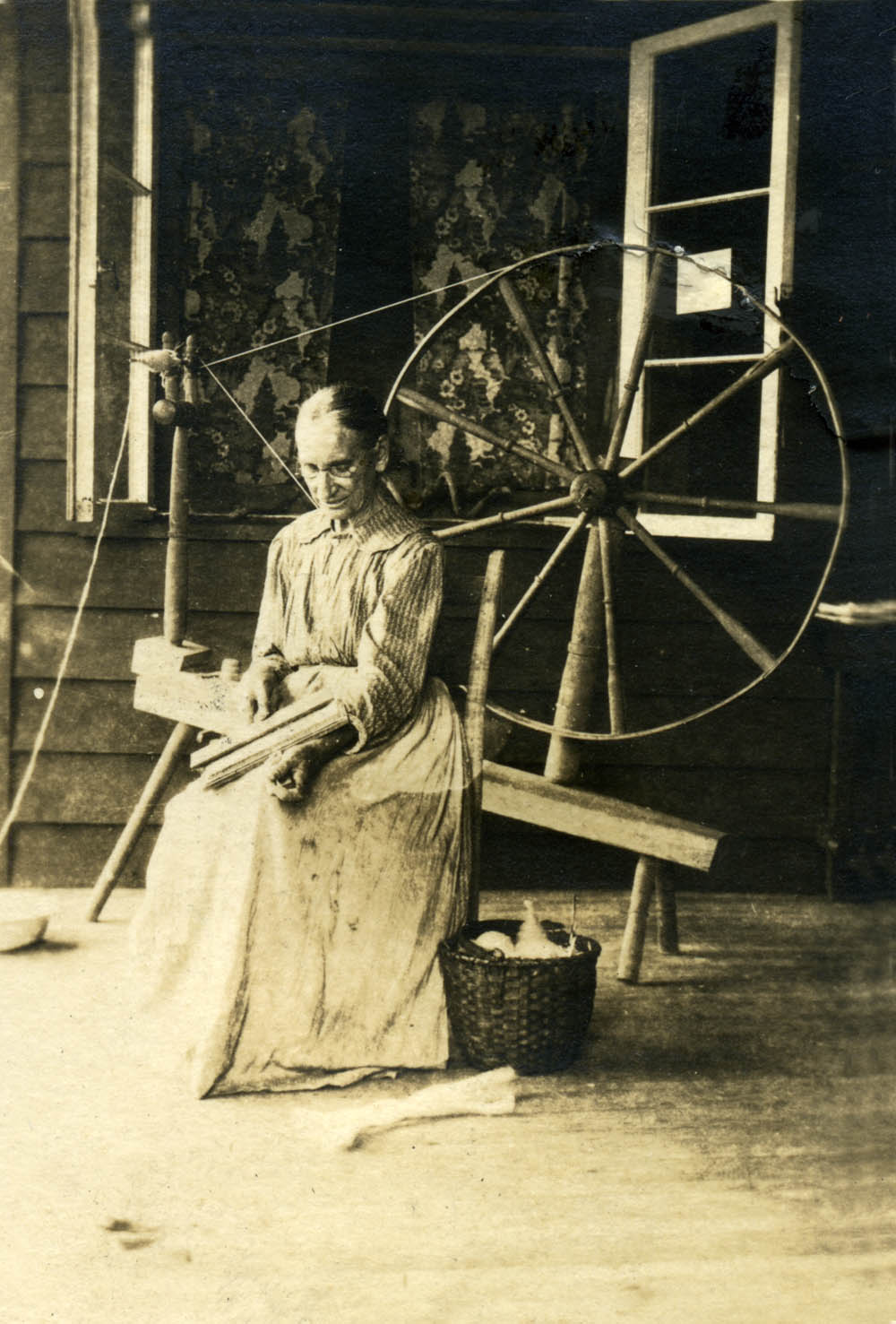
Aunt Leah Smith carding wool in front of spinning wheel at Far House, PMSS. Vl_37_1189b.jpg
EVELYN K. WELLS 1919 EXCERPTS FROM LETTERS HOME – September 14, 1919 – “The dogtrot of Old Log these days is filled with looms, and one finds Dosia (Docia) in one corner working on a gay pink and brown striped blanket, Arlena in another weaving one dyed with spruce pine, pale brown, and Ralph, aged twelve, at the big clumsy Colonial loom, barely able to touch the treadles, and just absorbed in the cotton counterpane he is making.“
FLORENCE REEVES “Aunt Phronnie Say by Her Fire Peeling Apples …” , 1922, page 3 -During a home visit, Reeves records a conversation with Phronnie, who tells of her delight “in the care of her flock of sheep and took peace and quiet as she carded and spun the wool and ‘trompt the treadle’ of her loom.”
HISTORY PMSS Summary 1954-1955 – “The farm had 5 beef cattle, introduced a sheep project and continued forest activity.”
HISTORY PMSS Summary 1955-1956 – “The sheep project continued.”
HISTORY PMSS Summary 1956-1957 – “…sheep project terminated.”
HISTORY PMSS Summary 1974-1975 (image 97) – “Wildflower and Bird Weekends, Summer Spinning Bee, led by local craftswoman Sarah Bailey and members of the Kentucky Weaver’s Guild. 119 attenders went through all the old-time intricate processes of shearing the sheep, carding and spinning the wool into yarn, dyeing yarn with vegetable dyes, and finally weaving the patterns. Textile Workshop.”
KATHERINE PETTIT Biography – “Both women [de Long and Pettit] encouraged the Appalachian people to be proud of their heritage and to work to preserve their arts, folk songs, and customs. For example, Miss Pettit learned about raising sheep, spinning wool, weaving traditional patterns, and using natural vegetable dyes from families who still practiced the old traditions and she then taught these skills to women and children who had not been exposed to these crafts.” ed.
KATHERINE PETTIT Correspondence 1911 My Dear Friend Letter, May 27, 1911, page 8 – “…[W]e had to hurry up to the head of Greasy to see Mrs. Shell and her coverlids [weavings]. She is over sixty years old and had just finished shearing her 100 sheep. Then we walked four miles along the foot of Pine Mountain down to Mr. [William] Creech‘s where they had looms, spinning wheels, hackles, etc., and had been longing for years for somebody to come along and tell them where they could get some flax seed to plant. They had been hoping for a school for 30 years and offered 100 acres of land. …”
MEMBERS OF THE HARLAN COUNTY MEDICAL SOCIETY 1932, page 4, chapter 1, “The Locality” – “A very few families depend upon goats for milk, but, in the main, cows are used in all the dairies, whether public or private. This mountainous region is the natural habitat for goats and their use should be encouraged. One man who has a pair of Nubian goats has a great desire to open a goat dairy and would do so if he were assured a market for the milk. The reasonable cost of a goat and its ability to thrive on much less food than a cow, with its large output of milk, makes it most desirable, especially to those with limited incomes. A few sheep herds roam the hills.”
NOTES – 1921, page 2 – An article describes Rhoda Melinda as a young weaver: “Before you round the bend of the road that hides you from the Old Log House, the thump of the batten tells you that the looms are busy. By the doorstep, hands of yarn simmer gently in the dye-pot. On the porch, hung on wooden pegs, reels, chairback, — anything that will hold them, — are the long skeins already colored with madder, hickory, walnut and other colors that in these days of autumn glory are close kin to the woods that surround us. Four of our children are weaving these days. Arlena and Rhoda Melinda are copying ancient striped blankets, throwing their shuttles almost as skillfully as their grandmothers might have done. Grace is a true enthusiast, a stern critic, too, of what is a spurious introduction into this ancient mountain craft, and what truly ‘belongs.’ Ralph, only eleven, is at work at the clumsy old colonial loom, his bare feet hardly able to ‘trop the treadles.’ His sample is a scrap of cotton counterpane rescued from an old patchwork quilt, over a hundred years old.“
NOTES – 1923 February – “The more we saw of these [hand-woven] blankets, the more we knew that our weaving, when it was started must be in the mountain style.”

Detail. weaving_pmss_fh_003_mod4
NOTES – 1944 COMMUNITY FAIR DAY, page 2, written by Alice Cobb – “The exhibit of old-fashioned household gear is one of the most unique features. There was, for instance, the comforter, madder red on one side, black-sheep brown on the other, bound with indigo piping, made by Aunt Sal’s mother. The same patient hand had fed and shorn, carded and spun and dyed, woven the cloth, and spread out the neat quilting in great even fans of small hand-stitches. (The comforter belongs to Dr. Oma Creech, a grand-daughter of Uncle William, now overseas with UNRRA.)
NOTES – 1956 – From Burton Rogers, page 2: “These warm spring days our fields present a peaceful, pastoral appearance where our flock of 93 ewes and their lambs are grazing. The flock, new last spring, is an experiment in suitable projects for a mountain farm but it is hard to look on a baby lamb as a dollars and cents investment. Soon they will be off to market, but now, with their wobbly legs and high-pitched [bleat], they are both picturesque and entertaining.”
NOTES – 1975 – Burton Rogers writes “…we have recently acquired several sheep to add interest to visiting classes and to be shorn during the Spinning Bee.”
NOTES – 1979 – Burton Rogers mentions “four sheep and five lambs, due to be shorn at next month’s Spinning Bee…”
NOTES – 1981 – Describes an EE class taking a tour of the campus. Page 3 mentions visiting the sheep and includes drawing of sheep & lamb by Mary Rogers.
PINE CONE 1941 – September, page 1 – “ANNUAL COMMUNITY DAY TO BE HELD OCTOBER 11 — HOST JUNIOR CLASS to dance and sing, eat ice cream, watch the set running and dramatization, practice sheep and hog calling; … Pine Mountain is keeping alive folk ways that are in danger of being lost or forgotten in the swift pace of the machine age….”
THE PINE MOUNTAIN STORY – CH. II, page 7 – “In the first year, while some School workers were still living in tents, the children learned from Aunt Sal and Uncle William [Creech] how to pull and break flax, and from other neighbors how to shear sheep, and card wool. The stored knowledge in the experience of the older folks was explored. Teachers from beyond the mountains learned how to spin and dye, how to set a blue pot, and how to weave beautiful coverlets. Aunt Sal could sum up the give and take between School and local people with these words: ‘I reckon things is about evened up in this world. You’ve been everywhere and seen everything, and I can spin.’”
PMSS BOT Meeting Minutes Spring 1955, page 2 – “The sheep project has been started and a sustained timber project is under way.”
PUBLICATIONS Mary Rogers Topical Index to NOTES 1918-1950 – Lists subjects in the PMSS publication, Notes from the Pine Mountain Settlement School by topic. The following are sheep and weaving-related subjects:
- Patterns & dyes in November 1921 NOTES;
- Spinning & weaving in February 1923 NOTES;
- Summer Winter weave, Blue Pot in March 1927 NOTES;
- Sale of coverlets in November 1927 NOTES:
- Sheep, dyes & weaving in February 1928 NOTES
SARAH BAILEY Student Staff – Biography of a PMSS student & worker (1940s) & a community folk artist known for her craftsmanship and workshop teaching of spinning, weaving and other crafts. (See also: ALICE COBB STORIES “About Sarah Bailey” 1940.) Excerpts:
- “… [S]he demonstrated how to shear, card, dye, and spin sheep’s wool.”
- “THE COMMUNITY. Old friends of the School would have especially enjoyed the Spinning Bee held last summer under the direction of Mrs. Sarah Bailey, neighbor and well-known craftswoman. She and members of the Kentucky Weaver’s Guild led the 119 attendees through all the old-time intricate processes of shearing the sheep, carding and spinning the wool into yarn, dyeing the yarn with vegetable dyes, and finally weaving the patterns. …”
- “On July 13, 1935, Sarah married Frank Bailey. The couple built their own house on a small farm where they raised a variety of farm animals, including sheep which provided the wool for Sarah’s spinning, weaving and knitting. …”
PMSS WORKERS 1913-2000s Guide – Weaving Teachers and Enthusiasts
- ANNA ANDERSON (Mrs. Gibbey Erwin) – Weaving at Med. Settlement with Chloe Smith, 1937-1938
- SUSAN M. BROOKS – Weaving teacher; “Had a ‘blue pot’ – a blue dye for wool containing bran, indigo, etc., that needed to be kept at constant temperature” and was located in the weaving room at Girls’ Industrial,1933 – June 1936
- CHLOE SMITH (Mrs. Hayes Bunch) – Weaving at Medical Settlement 1938-1939
- ABBY CHRISTENSEN – Weaving, Dec 1944 – Jun 1949; Dancing 1933-on; Mechanical Drawing 1944-1945; Craft Teacher (Weaving) Dec 1944 – Jun 1949
- FLORENCE DANIELS – Fireside Industries, Weaving, 1925-1928
- VERNA FLOETER (Mrs. William Damon) – Weaving, 1936-1937
- MARTHA HENSON – Weaving, Jan 1930 – June 1930
- MARY BRADSHAW HOLSINGER (Holzinger?) – Weaving teacher, 1948-1955.
- BECKY MAE HUFF (Mrs. Ova Sexton) – Weaving teacher, 1930 (1931?) – 1932. She spent a few days in Saluda, NC, with Helen Stone Viner, a former PMSS housemother, for dyeing lessons.
- RUBY LANIER – PMSS bookkeeper & secretary 1947-1962 – A long-time weaver & admirer of the arts, she retired to Chapel Hill, NC, where she continued her craft enterprises.
- BEATRICE PETERS (Mrs. Perry?) – Weaving, 1957-1959
- ALICE CARTER SHERA – Teacher, Arts & Weaving 1934-1936.
- HELEN STONE (VINER) – PMSS housemother 1914-1922, who established a weaving cooperative and a retail store in Saluda, NC, after PMSS. She and her husband wrote The Katherine Pettit Dye Book.
- BERNICE TERRY (Mrs. Hiser) – Weaving, October 1929
WILLIAM CREECH – A SHORT SKETCH OF MY LIFE – Uncle William raising sheep before PMSS created: “By raising flax and sheep my wife carded and spun and wove cloth to make clothes for us all….”
PAGES SPECIFICALLY ABOUT DYEING, SPINNING, WEAVING
DANCING IN THE CABBAGE PATCH Weaving at PMSS 1930s-1940s (Post)
DANCING IN THE CABBAGE PATCH Weaving at PMSS Beginnings (Post)
EDNA MAE METCALF PATTERSON – Biography of a PMSS student in the 1920s who later served as a weaving teacher, plus an assistant in a variety of roles from the 1930s to 1960s.
FLORENCE DANIELS – Biography of a weaving instructor at PMSS, 1926-1929. She was well-known and respected in the weaving field for 50 years.
KATHERINE PETTIT DYE BOOK – lmages & transcription of a manual compiled in 1946 by Helen Wilmer Stone Viner (housemother, 1914-22) and husband. From KATHERINE PETTIT Biography: “The dyeing practices were recorded in The Katherine Pettit Book of Vegetable Dyes by Wilmer Stone Viner, who worked as a housemother for six years at Pine Mountain Settlement School. In 1946, after moving from Kentucky to Saluda, North Carolina, Miss Viner married and she and her husband published the 63-page book based on the dyeing practices she had learned from the community and from Pettit. She dedicated the book to the memory of Katherine Pettit.“
KATHERINE PETTIT – Weaving at PMSS – Beginnings
MARGARET MOTTER TALK: COLONIAL COVERLET GUILD, 1948.
WEAVING at Pine Mountain Settlement School – GUIDE – A brief history, locations of weaving ephemera at PMSS & links to weaving articles.
WEAVING Draper Loom Studio
WEAVING SAMPLES Pine Mountain Settlement School I
WEAVING SAMPLES Pine Mountain Settlement School II
FIRESIDE INDUSTRIES
ALICE COBB STORIES March of Time in Greasy Valley 1935 – “Today the fireside products bring in a little money to some of the men and women in the community, and this is the only reliable source of income whatsoever. The hours are long, the work is tedious, and the returns are small, and yet when one considers that the hours without such occupation, for the most part, are worth nothing, and life without them is deadly dull, the fireside industry would seem to be a pointing finger to those who are trying to bring new hope to the mountain people.”
BIG LOG – “Following the early occupation by staff, the building in the 1920s was designated as the weaving center and housed the hand-weaving activity of the Fireside Industries of the School.”
FIRESIDE INDUSTRIES SCRAPBOOK WELLS RECORD 13 PMSS Fireside Industries 1913-1928
GIRL’S INDUSTRIAL BUILDING – 1924-1925 Fireside Industries & Home Economics classes.
GLYN MORRIS STUDY & RECOMMENDATIONS II HISTORY – “Weaving and other crafts — A Fireside Industries Department was begun in 1921, and for a number of years weaving and other crafts were carried on. Because proportionately it did not seem to be financially successful, and because it offered little economical possibility for the students in after life, it was discontinued in 1939.”
HISTORY PMSS Summary 1937-1938 – Settlements: Medical Settlement, Big Laurel, carried on classes, projects, and Fireside Industries Weaving Department, using weaving looms moved from PMSS campus, was operated by Chloe Smith and Anna Anderson at the Medical Settlement as “The Dye Pot and Loom.”
NOTES – 1923 February, page 1-2 – “Our Fireside Industries Department has saved from extinction in this end of the county, an art compounded of many lesser arts. One more generation, and the dye recipes would have been forgotten, the spinning wheels would have been merely ‘old truck,’ as hand looms had already come to be. …”
NOTES – 1927, pages 3-4 – Compares machine-made coverlets to those made by hand.
PINE CONE 1933 November, page 1 – “Mrs. Roosevelt Buys Fireside Industries Product….”
PMSS WORKERS 1913-2000s GUIDE – FIRESIDE INDUSTRIES
- DAISY BILBREY (Mrs. Hancock) – 1921-1922
- FLORENCE DANIELS – 1925-1928 weaver
- LUCY NICHOLSON – 1923-1924 (link) – A weaver and, in 1923-1924, in charge of Fireside Industries, a department at PMSS that encouraged and sold locally-made crafts.
- SABRINA RITCHIE – 1922-1923 weaver
- ELEANOR C. STOCKIN (Mrs. Walter H. Sears) – 1924-1925
RECORD Pine Mountain Settlement School 03 – 1924-1925 – “EVENTS: Summer and Winter Weave in Fireside Industries Department”
SCRAPBOOK BEFORE 1929 – William Aspenwall Bradley “The Women On Troublesome” 1918 – “New interests have been created, new opportunities opened for them, especially through the renewal of such “fireside industries’ as basketry and weaving, which were beginning to disappear owing to the introduction of cheap manufactured articles from without. The school now finds a market outside the mountains for the product of these women’s inherited skill, and it has in the last few years sold for their account thousands of dollars worth of blankets, coverlets, linsey-woolsey and other homespun fabrics, and baskets.”
WELLS RECORD 13 PMSS Fireside Industries 1913-1928
DYES, DYEING, DYE BOOKS
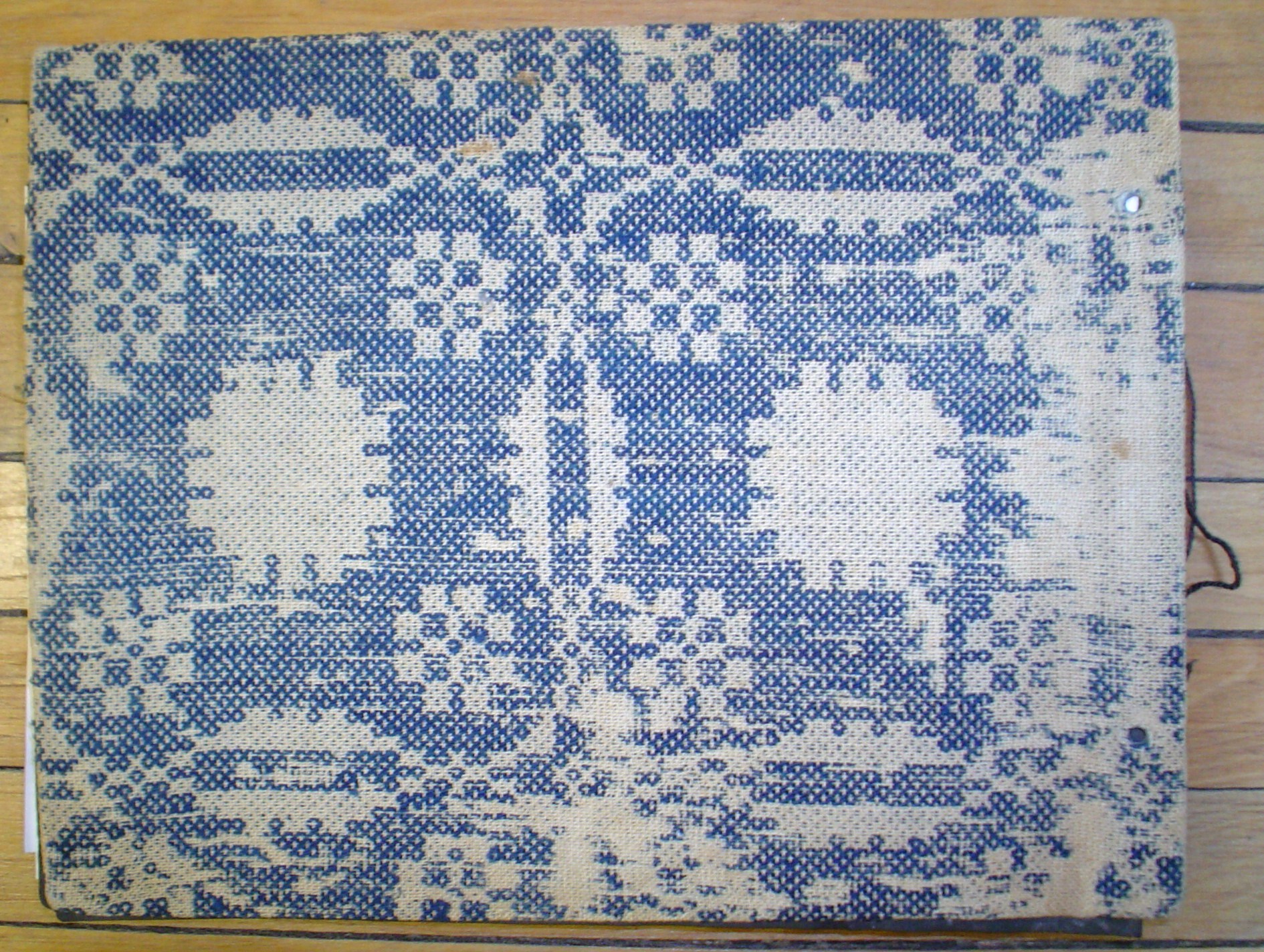
Margaret Motter Album – Woven Front Cover, well-worn, ‘Summer and Winter’ weave Indigo ‘Blue Pot’ dye. mott_cover2.jpg
ABBY WINCH CHRISTENSEN Biography – “Many of her weavings still remain at the School. As a botanist, she was interested in vegetable dyes and apparently practiced the art of vegetable dying while at the School.“
ALICE COBB STORIES
ALICE COBB STORIES March of Time in Greasy Valley 1935 – “…Grannie Hall dipping vegetable dyes and weaving rare patterns in rare colors….” “The occasion for my visit was to inquire about the specific recipe for a blue-pot. She was very willing, but vague. A pinch of this and some of that, and put them all in together, and set the pot. ‘After a while hit begins to smell bad.’ There were a few other equally vague directions, and with them I had to be content, meanwhile admiring her blue-pot, which was smelling worse every moment. And one must be impressed with the fact that this blue-pot simmering in a back yard is actually a possession of the hills.“
ALICE SHERA CORRESPONDENCE – Teacher, Arts & Weaving 1934-1936. In a letter dated May 8, 1934, to Glyn Morris, she waxes ecstatic regarding her dye-pot work and suggests that a “Pine Mountain Green” could be a unique and profitable color for the school.
EDNA MAE METCALF PATTERSON Biography – Edna Mae recalls “We didn’t have all these things we use as mordant now. Then we used vinegar and salt to set the dye. As I grew older and became connected with the Settlement School, they did vegetable dyeing.”
HISTORY PMSS Summary 1937-1938 – “The Dye Pot and Loom” weaving project, under the supervision of PMSS, was operated by two former students at the Medical Settlement at Big Laurel. PMSS supplied the looms, and was marketing agency for the weaving.
HISTORY PMSS Summary 1960-1961 – A weaving workshop which was held in February under the auspices of the Southern Highland Handicraft Guild generated renewed activity in vegetable dyeing and weaving.
LUCY NICHOLSON – Biography: In a letter dated May 17, 1923, from Katherine Pettit to Nicholson: “I want you to understand that we are interested in very special problems at Pine Mountain. We want to revive and keep alive the old vegetable dyes, particularly the old indigo blue. We also want to make articles which are exactly like the old-fashioned mountain weavings, —the striped blankets and coverlets and towels and linsey, — not bag and table runners and small things which many schools manufacture, and which do not really belong to the mountains. …”
USDA “Home Dyeing with Natural Dyes” 1935
Viner, Helen Wilmer Stone. KATHERINE PETTIT BOOK OF VEGETABLE DYES, Excelsior Printers, Saluda, North Carolina 1946.
PHOTOGRAPHS: Sheep, Spinning, Weaving, Dyeing
029 V Environmental Education Indians and Settlers – 1970s color photographs of an EE group of children observing sheep, weaving, carding, spinning wheels, looms, woven fabrics, vegetable dye samples.
108 ETHEL McCULLOUGH Photograph Album 1914 Part 2B singles – Three photos of people at spinning wheels.
KATHERINE PETTIT Social Settlement in Kentucky Mountains Sassafras Album 1901 – Donated to Pine Mountain by Katherine Pettit, is a rare glimpse into the distant past of the craft of weaving. The small album captures the unique processes used by Appalachian mountain families who sheared their sheep, washed and carded their wool, spun the wool and then wove it into complex patterns.
MALCOLM ARNY – Staff – Suzanne Arny Fuller describes two of the family photographs that she contributed to her parents’ biographies: ” …there are my sons, Michael and Eric, with Burton in the 1980s. They loved to help him herd the sheep from near Big Log to below Laurel House.”
MARIAN KINGMAN Photograph Album – Photographs of sheep and woven fabric.
NOTES – 1986 May, page 6 – Photograph of a “Plant Dye Workshop with an Elderhostel.”
SARAH BAILEY Student Staff Biography – Several photos of Bailey, a well-known community folk artist, at the spinning wheel.
VI 45 FRIENDS & NEIGHBORS Occupations, Schools, Local Houses, Buildings II – Three photographs of (“Aunt Sis”) Shell, Uncle John D. Shell and Mrs. Day shearing sheep.
VII 64 LIFE WORK MAINTENANCE, FARM, GROUNDS I – Three photographs of sheep.
GALLERY: Additional Photographs of Sheep, Spinning
- Angela Melville Album. “‘Aunt Jude’ Turner, Big Laurel, about 1925,” feeding sheep. [nace_II_album_008.jpg]
- Barn. Farm crew shearing a sheep. [II_7_barn_284.jpg]
- Frances Lavender Album. Aunt Lear (Leah) spinning. — See wool laying on the wheel and her hand in motion. [lave018.jpg]
BIBLIOGRAPHY – SHEEP, WEAVING, DYING. SOME OUTSIDE RESOURCES
Clark, Thomas D. Agrarian Kentucky. University of Kentucky Press, 1977. (Kentucky Bicentennial Bookshelf).
Eaton, Allen H, and Lucinda Crile. Rural Handicrafts in the United States. Washington: U.S. Govt. printing Office, 1946. [Mentioned in “MARGARET MOTTER TALK: Colonial Coverlet Guild.“]
EARTH GUILD, Asheville, NC. “Earth Guild provides the tools and materials for serious craft work, and the information necessary to put those tools to work.” (Contact Earth Guild for marketing naturally dyed wool and handcrafted wool products). https://www.earthguild.com/
Hall, Eliza Calvert (Lida Obenchain). A Book of Handwoven Coverlets, 1931. .”Lida” Eliza Caroline was a suffragist, women’s rights advocate, author, and weaving enthusiast from Bowling Green, Kentucky.
HATHI TRUST. Search “Kentucky Sheep” 659,070 Full-Text results
HATHI TRUST. “Pine Mountain Settlement School” weaving
Heard, Marian G. Craft Education Project Questionnaire: Wilmer S. Viner, Vegetable Dyer and Weaver. Southern Highland Craft Guild, n.d. Internet resource.
SCRAPBOOK Before 1929 Guide, page 27 – The Club Woman, Kentucky Federation of Women’s Clubs, Vol. 6, No. 6, 1925, includes articles on: “Berea Weaving,” “Fireside Industries.”
Spence, Carol Lea. “No Business Like Sheep Business” – The MAGazine, UK College of Agriculture, Summer 2013. “Kentucky sheep producers are tapping into a rich history. Stone Age humans domesticated sheep 10,000 years ago in Asia Minor—the first farm animals on record. They were easy to handle, and they produced meat, milk, fiber, and shelter.“
Viner, Helen W. S. Katherine Pettit Book of Vegetable Dyes. John C. Campbell Folk School, n.d.
Viner, Helen W. S. Woven Cloth Sample Notebook. Southern Highland Craft Guild, n.d.
Viner, Helen W. S. Woven Hanging with Floral Centerpiece. Southern Highland Craft Guild, n.d.
Viner, Helen W. S. Woven Throw. Southern Highland Craft Guild, n.d
WEAVING Periodicals, Ephemera, Books (draft in progress) – A list of weaving-related items in the PMSS Archives, such as brochures, pattern books, catalogs, documents, instructions.
The Woolery Frankfort, Kentucky. One of the world’s largest online selection of equipment & supplies for the fiber artist. [currently limited hours]
Kentucky Sheep Producers Association (SEKSPA)
SEE
FARM and FARMING
FARM and FARMING Guide

